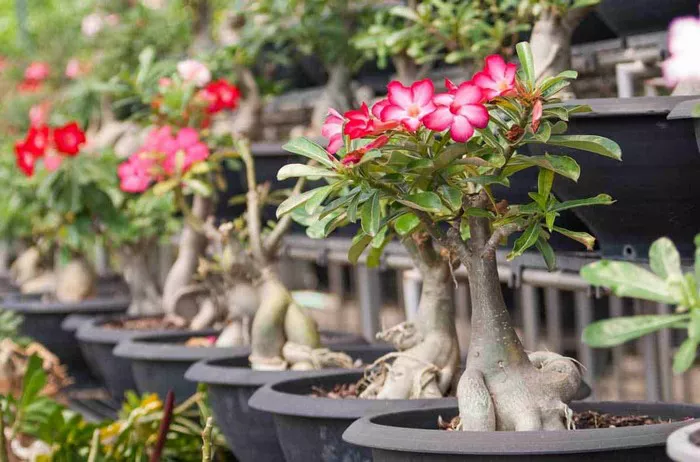Basic Desert Rose Facts
Desert rose (Adenium obesum) is a striking succulent plant native to arid regions of Africa and the Arabian Peninsula. Its unique appearance, with swollen trunks and colorful, trumpet-shaped flowers, makes it a popular choice among plant enthusiasts worldwide. Despite its name, the desert rose is not a true rose but belongs to the Apocynaceae family. It thrives in hot, dry climates and is well-suited to indoor cultivation in temperate regions.
Light and Temperature Requirements
To thrive, desert roses require plenty of sunlight. Place them in a location where they can receive at least 6-8 hours of direct sunlight each day. Indoors, a south-facing window is ideal. In hotter climates, some afternoon shade can help prevent sunburn on the leaves.
Desert roses are sensitive to temperature fluctuations. They prefer warm temperatures between 65°F and 90°F (18°C to 32°C) during the day and slightly cooler temperatures at night. Protect them from drafts and sudden temperature drops, especially during the winter months.
Watering Needs
Proper watering is crucial for the health of desert roses. While they are drought-tolerant plants, they still require regular watering, especially during the growing season (spring and summer). However, it’s essential to let the soil dry out between waterings to prevent root rot.
Water your desert rose thoroughly, allowing excess water to drain away. Ensure that the pot has adequate drainage holes to prevent water from pooling at the bottom. During the dormant season (fall and winter), reduce watering to prevent overhydration, as the plant’s water needs decrease.
Soil and Potting
Desert roses thrive in well-draining soil mixtures. A combination of sand, perlite, and potting soil works well to mimic their native growing conditions. Avoid heavy, water-retentive soils, as they can lead to root rot.
When choosing a pot for your desert rose, opt for a container with drainage holes to prevent waterlogging. Terra cotta pots are excellent choices, as they allow for air circulation and help wick away excess moisture from the soil. Select a pot that provides ample room for the plant’s roots to grow, but avoid oversized containers, as they can hold too much moisture.
Fertilizing
Fertilizing is essential to ensure the healthy growth and blooming of desert roses. During the growing season, apply a balanced liquid fertilizer diluted to half strength every 2-4 weeks. Alternatively, use a slow-release granular fertilizer formulated for flowering plants according to the manufacturer’s instructions.
Avoid over-fertilizing, as this can lead to salt buildup in the soil, causing damage to the roots. During the dormant season, reduce or stop fertilization until the plant resumes active growth in the spring.
Pruning and Shaping
Pruning helps maintain the shape and size of your desert rose while promoting bushier growth and more abundant flowering. Prune your plant in late winter or early spring before new growth begins. Use sharp, clean pruning shears to make clean cuts and prevent the spread of diseases.
Remove any dead, damaged, or crossing branches, as well as any suckers emerging from the base of the plant. You can also prune to shape your desert rose, creating a more compact and attractive appearance. Avoid excessive pruning, as this can stress the plant and reduce flowering.
Common Problems and Solutions
Despite their hardiness, desert roses can still encounter several common issues, including pests, diseases, and leaf drop. Spider mites, mealybugs, and aphids are common pests that may infest desert roses. To control pests, rinse the plant with a strong stream of water or treat with insecticidal soap according to the manufacturer’s instructions.
Overwatering is a common cause of root rot in desert roses. To prevent this, ensure proper drainage and allow the soil to dry out between waterings. If you notice yellowing or wilting leaves, check the soil moisture and adjust your watering routine accordingly.
Leaf drop can occur due to environmental stress, such as sudden temperature changes or insufficient sunlight. Ensure your desert rose is placed in a stable environment with adequate light and temperature levels.
Propagation
Propagation allows you to expand your collection of desert roses or share plants with friends and family. The most common methods of propagation include from seeds or stem cuttings.
To propagate from seeds, collect mature seed pods from your desert rose and allow them to dry for several days. Sow the seeds in a well-draining potting mix and keep them moist until germination occurs.
For stem cuttings, select a healthy, non-flowering stem and cut it just below a node using a sharp, clean knife or scissors. Allow the cutting to callus for a few days before planting it in a well-draining potting mix. Keep the soil moist until roots develop, usually within a few weeks.
Overwintering
During the winter months, desert roses may require special care, especially in colder climates where temperatures drop below freezing. If you’re growing your desert rose outdoors, consider bringing it indoors before the first frost. Place it in a bright, sunny location away from drafts and heaters.
If your desert rose is too large to move indoors, you can protect it from frost damage by covering it with a frost cloth or blanket overnight. Additionally, avoid watering during cold spells, as wet soil can freeze and damage the plant’s roots.
Conclusion
In conclusion, caring for a desert rose plant requires attention to its specific needs, including light, water, soil, temperature, and pruning. By providing adequate sunlight, well-draining soil, and careful watering, you can ensure the health and vitality of your desert rose. Proper fertilization, pruning, and pest management are also essential for promoting growth and preventing common issues. Whether you’re a novice gardener or an experienced plant enthusiast, following these guidelines will help you cultivate thriving desert roses that reward you with their striking blooms and resilient beauty year after year. With a little care and attention, your desert rose plant will continue to brighten your space and delight your senses for seasons to come.


